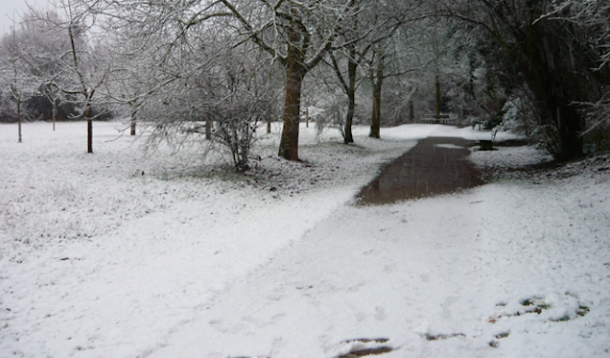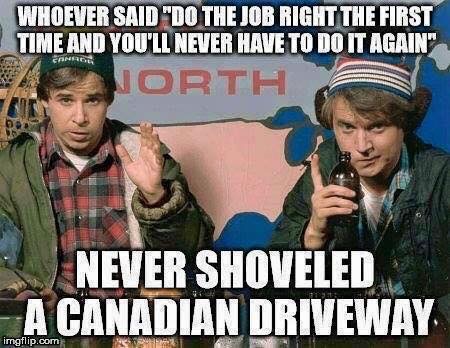
"Winter is Coming" memes aren't a huge thing for no reason; if there's one thing most of humankind is united in, it is our strong distaste of cold and ice. For those of us lucky to be born or live in Canada, this is a place where "Winter is Coming" is more than a meme; it's actually our calendar. It goes like this:
May to September = winter is coming
October to April = winter is here, and also STILL coming.
And it may be passé but it is true: there is a lot to be found in the way of happiness outside in Canada even in the winter, but with one caveat: that you are prepared for it. It will never be money wasted on these five crucial items to a happy winter in Canada, no matter which province, territory, or godforsaken ice island you holed yourself up on after they cancelled Firefly.

Buy good stuff! It doesn't need to buy name brand or high-fashion, but please, get the warmest you can afford and sell it after the reason if you need to recoup costs. You can buy five pairs of thin, easily ripped mittens for your kids every year, or one to two really good, insulated pairs that allow them to keep all their finger and come with the added bonus of they will actually go outside and leave you to your incredibly important work of crocheting that scarf Claire always wears on Outlander. (TV narrowly escaped being #6 on this Canadian survival list.)
The worst for me in the winter is cold and frozen toes. I LITERALLY cannot be nice to people when my feet are cold. I hate the feeling, and a lot of the boots I've had over the years are impossible to stay upright in while trying to navigate the seemingly always icy sidewalk in front of our house and school.
While in my (unknowing) past I may have coveted boots more for fashion than function, it is now, as a mom and commuter and dog owner that a slip and fall would knock me down and out, and I can't imagine running from school drop-off to train to subway in slippery heels with freezing feet. Winter - even in suburbia and city - can be a tricky proposition.
I attended an ice walk – yes, on purpose; invited by the kind people at Mark's – to see exactly how grippy slip-resistant boots were. I have to be honest: I was fully expecting to break either a hip or worse – my writing hand – even though I was assured these boots were a technical marvel. We all know that we're supposed to salt and clear walkways, and most of the time most of the people do. But that isn't always the case for pathways up to schools or a walk with the dog to the park or even a quick trip for something to add to our evening hot adult beverage. It would be my luck to fall and break a bone at the entry to the liquor store, and even more likely that my high school nemesis would at the same time be exiting to step over my broken body.
The Toronto Rehabilitation Institute (TRI) actually studies winter boots and rates them, according to what slope degree they slip at and then measures this with something called the Snowflake Rating System. To get one snowflake, boots need to meet the minimum standard - walking on a seven degree slope without slipping (FYI: this is the slope of a curb on a sidewalk). Guess how many of those tested actually failed? 90%. Ninety! So Mark’s and the Toronto Rehabilitation Institute have been working for the last eight years to develop and set a measurable standard for slip resistant footwear.
I've worn many expensive name brand boots in my quest for warmth through almost 40 winters and these things were top of the list for sure. They stuck to ice and they kept my feet not only comfortable but warm and that's a winter win/win. These boots really do stick to the slippery surface and they are warm as they come, which means I AM A NICER PERSON WHEN WEARING THEM!
Get comfy, durable, rugged equipment. And while you're at it, round up some able-bodies to help if you don't have any teenagers. This is definitely a "throw money at it" problem if at all possible. If none of this is a possibility, try being extra nice to any neighbours who DO have snowblowers. Commit to forced eye-contact when they are snow-blowing merrily and you're armpits deep in that ridge the snowplow just deposited at the end of your driveway. In my experience, the sustained eye contact guilts people pretty quickly. Crying can also help, from a prone position if drastic measures are warranted.

Take this from a woman, who for two years, battled snow and ice (including winter of '07) with nothing more than an old dollar store spatula. Spite will get you far sometimes, but now is not the time to dig your heels in over who in your house is responsible for replacing the broken one in the car trunk. Buy one and hide it if you must, but get a good telescopic reach one for yourself.
You don't need to go all survivalist here; simply enough of the basics to get you through a possible few days should an ice storm or extra large dumping of snow occur. Think of things needing little to no preparation or cooking if possible, like granola bars, cereals (milk can be kept outside short term if power quits) and canned goods. Oh, and toilet paper - you have the potential to become a millionaire, since toilet paper will be the currency of the future if we have an ice apocalypse.
Being cold and fearful of falling is the absolute worst. But I love Canada and all of its benefits too much to even think about moving to a warmer climate. Embracing - and preparing for - winter is something we can bond over (even if it is just with mutual seasonal disdain) is really the Canadian way.

IMAGE SOURCES: DLMCK VIA GETTY IMAGES; imgflip; MARK'S.

This is proudly sponsored by our friends at Mark's.